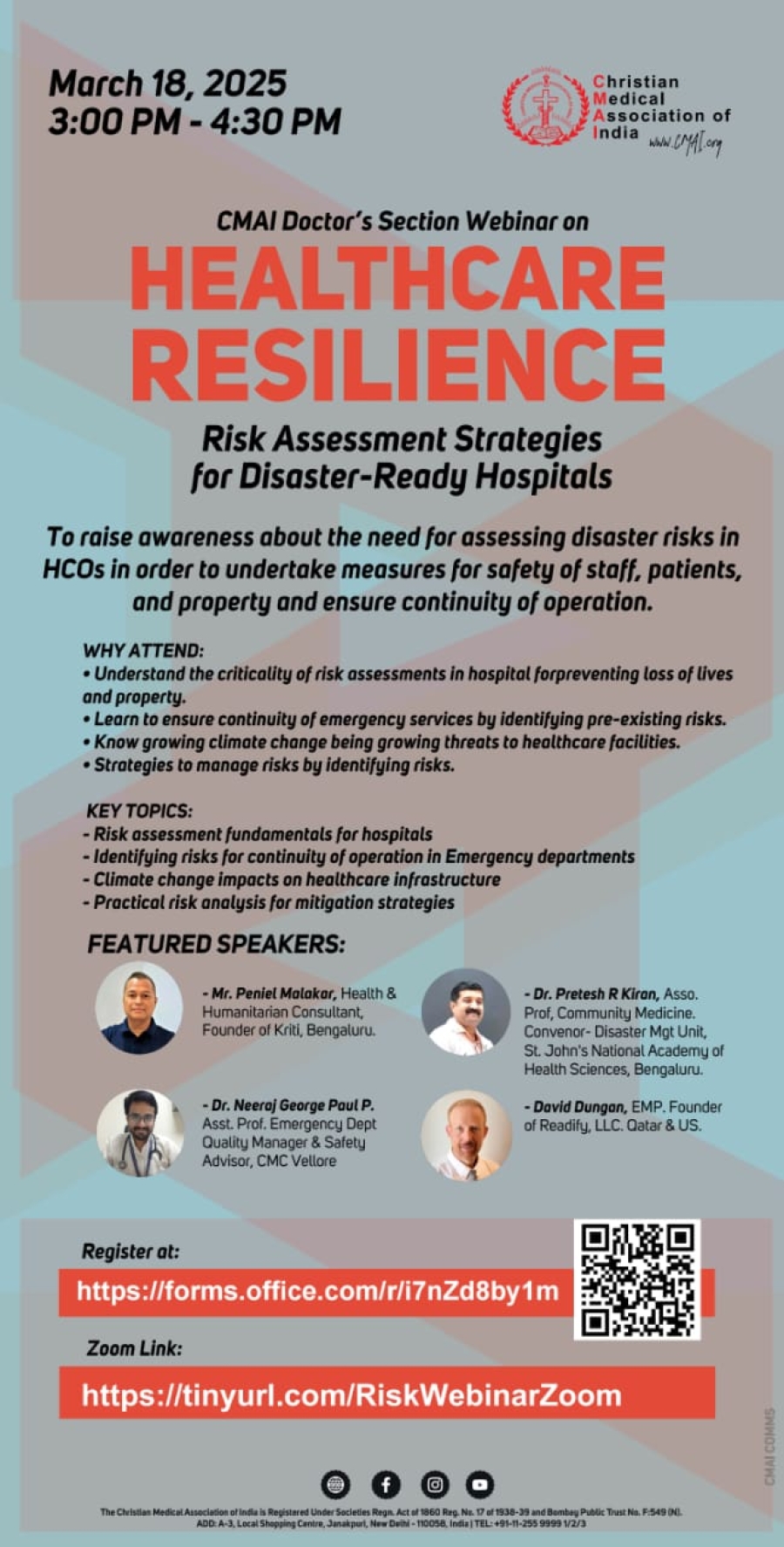The CMAI Doctors Section hosted a webinar titled "Healthcare Resilience: Risk Assessment Strategies for Disaster-Ready Hospitals" on March 18, 2025, as the first in a series on disaster management. The 90-minute session featured four experts who addressed various aspects of disaster preparedness and risk assessment for healthcare facilities. Dr Abhijeet Sangma moderated the event, which began with an opening prayer by Dr Rajiv Joy Nathan, chairperson of the CMAI Doctors Section.
YouTube link to the Webinar recording: https://www.youtube.com/watch?v=x7mmH4Xj6i4&pp=ygUMY21haSB3ZWJpbmFy
SPEAKER PRESENTATIONS
Mr Peniel Malakar (Health & Humanitarian Consultant, Founder of Kriti): Mr Malakar emphasised the critical need for assessing disaster risks in healthcare facilities. He highlighted that no place on earth is safe from disasters, presenting examples of hospitals affected by floods, storms, and fires across India. He stressed that "failing to prepare is preparing to fail" and that while disasters cannot be prevented, their impact can be mitigated through proper risk assessment. Mr Malakar explained that risk assessment should be comprehensive, identifying both internal and external risks, and should prioritise departments and actions based on urgency and available resources. He concluded that the cost of recovery is much higher than the cost of prevention, making risk assessment the first critical step in hospital disaster preparedness.
1. Mr Peniel - Healthcare Resilience.pptx
Dr Neeraj George Paul (Emergency Department Quality Manager, CMC Vellore): Dr Neeraj focused on ensuring continuity of emergency services during disasters. He shared real-world examples of hospital emergencies including oxygen shortages, fires, and floods that disrupted critical care. He presented a structured approach to risk assessment in emergency units, explaining how to identify, evaluate, and prioritize risks through incident reporting, staff feedback, simulation drills, and patient outcome tracking. Dr Neeraj demonstrated CMC Vellore's risk matrix methodology that evaluates both probability and impact of risks to generate a risk score. He emphasized the importance of preparing for patient surges, addressing environmental risks like fire safety, and ensuring emergency exits are functional and accessible. He shared CMC's experience with mass casualty incidents and how they identified gaps in their response capabilities.
2. Mr Neeraj - Risk Assessment.pptx
Dr Pretesh R Kiran (Disaster Management Unit Convenor, St. John's Academy): Dr Pretesh addressed climate change impacts on healthcare infrastructure. He presented data showing India as highly vulnerable to natural disasters, with an average of eight major calamities annually. He detailed how extreme heat waves, monsoon flooding, cyclones, droughts, air pollution, and landslides specifically affect healthcare facilities through infrastructure damage, power outages, water scarcity, and access disruptions. Dr Pretesh highlighted unique vulnerabilities in Indian healthcare facilities, including limited backup power, aging infrastructure, inadequate building codes, and facilities located in high-risk areas. He emphasised the need for climate-resilient healthcare facilities that can withstand and adapt to changing environmental conditions, using Bangalore as a case study of increasing temperatures, water scarcity, and urban flooding.
3. Dr Pretesh - Climate Risks.pptx
Mr David Dungan (Founder of Readify, LLC): Mr Dungan compared international risk assessment tools and frameworks for healthcare facilities. He reviewed four major assessment tools: FEMA's Threat Hazard Identification and Risk Assessment (THIRA), WHO's Strategic Tool for Assessing Risk (STAR), Kaiser Permanente's Hazard Vulnerability Analysis (HVA), and WHO's Hospital Safety Index (HSI). He explained the strengths and limitations of each tool, noting that many lack objective impact measurement or are not specifically designed for healthcare settings. Mr Dungan then introduced RetifyRM, a Microsoft SharePoint-based risk management application that incorporates elements from these established frameworks while addressing their limitations. The tool provides structured assessment of organisational capabilities, objective impact analysis, and automated mitigation planning and tracking.
4. Mr David - Practical Risk Analysis tools.pptx
PANEL DISCUSSION HIGHLIGHTS. The panel addressed several key questions:
1. Minimum risk assessment for small facilities with limited resources. Mr. Malakar emphasised the need for comprehensive assessment but phased implementation, prioritizing areas of immediate threat where action is feasible.
2. Prioritising emergency services during disasters. Dr Neeraj explained how triage criteria were modified during COVID-19, emphasizing that ICU patients, those requiring oxygen, and dialysis patients should receive priority. He stressed the importance of identifying surge capacity and implementing appropriate protocols.
3. Climate change impacts on Indian hospitals. Dr Pretesh noted that impacts vary by region—heat and pollution in North India, flooding in coastal and southern regions, and urban flooding in metropolitan areas. He emphasized the need for location-specific planning.
4. Risk assessment tools for South Asian context. Mr. Dungan recommended tools that clearly and objectively assess capabilities and vulnerabilities while being simple to use and understand. He stressed the importance of prioritization and integrating assessment with the organization's broader risk management framework.
5. Single most important step for hospital administrators. The panelists emphasized: fostering a culture of safety (Mr David), accepting vulnerability and preparing accordingly (Dr Neeraj), developing and testing preparedness plans (Dr Pretesh), and conducting regular drills and physical verification of safety measures (Mr Peniel).
The panel also discussed ISO certification challenges, noting that certificates alone don't ensure safety without proper implementation and a culture of safety. They emphasised learning from past disasters, avoiding repeated mistakes, and the importance of honest incident reporting without fear of repercussions.
The webinar concluded with key takeaways: risk assessment is an ongoing process requiring regular updates; continuity planning must prioritize both critical services and staff well-being; climate change considerations should be integrated into all disaster planning; and implementation requires customization to each facility's specific context. The moderator announced that future webinars in the series would focus on risk management implementation and other aspects of disaster preparedness.



